- solen.cz - Atopic eczema in children and skin care for atopic children
- solen.cz - Diet in the treatment of atopic eczema in childhood
- prolekare.cz - Atopic eczema - what's new?
- prolekare.cz - Atopic eczema
- prolekare.cz - Atopic eczema in children: another harmful consequence of parental divorce
- prolekare.cz - Atopic eczema and environmental factors adversely affecting its course
- ncbi.nlm.nih.gov - Atopic eczema
- webmd.com - Eczema (Atopic Dermatitis) Treatment
- sciencedirect.com - Eczema
Atopic eczema: what is it, why does it arise and what are its symptoms?
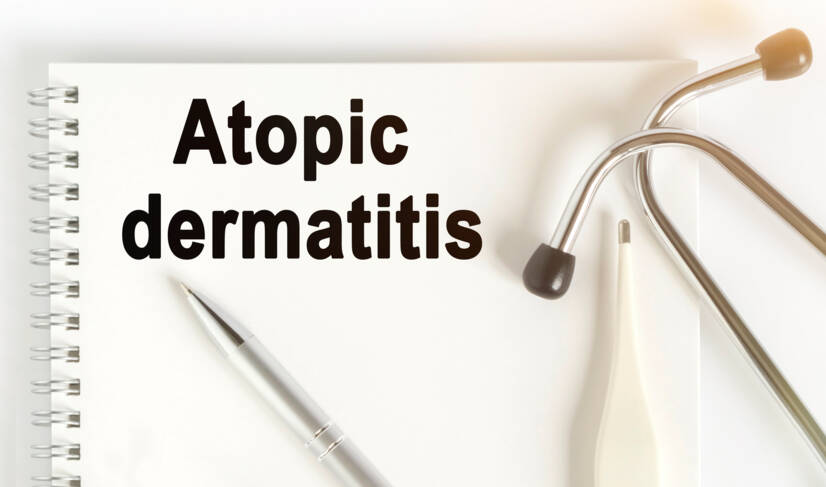
Atopic eczema is the most common chronic inflammatory disease in children. What are the causes of the disease?
Most common symptoms
- Malaise
- Skin pain
- Spirituality
- Increased body temperature
- Nausea
- Scars
- Brittle nails - onychoschizia
- Brittle hair
- Wetting of the skin
- Excessive Hair Loss: Causes, Treatment
- The Island
- Blisters
- Dry skin
- Itchy skin
- Itchy scalp
- Fatigue
- Reddened skin
Characteristics
Atopic eczema can be found in the literature under various synonyms, such as atopic dermatitis, prurigo Besnier, neurodermatitis atopica.
The word "atopy" is derived from the Greek word atopos = strange, unusual.
In 1982, the French dermatologist E. H. Besnier was the first to describe the link between atopic eczema, allergic rhinitis and asthma. Ten years later, Coca and Cooke used the term atopy for the triad of symptoms (eczema, allergic rhinitis and asthma).
Atopic eczema is defined as a multifactorial non-infectious inflammatory disease. The disease is characterised by an alternating asymptomatic phase with recurrent flare-ups.
Atopic eczema affects approximately 15 to 30 % of children and 2 to 10 % of adults. Approximately 45 % of cases occur within the first six months, 60 % within the first year of life and up to 85 % of cases occur within five years of life.
In childhood, boys are particularly affected. Later in life, women are more likely to suffer from atopic eczema.
The prevalence of the disease is increasing and is expected to continue to increase in adulthood and old age. On the positive side, up to 70 % of patients experience a reduction or disappearance of symptoms before adulthood.
Atopic eczema has a negative impact on the patient's quality of life. The patient must take care of his/her skin throughout the day and must attend regular medical check-ups.
The patient suffers from disturbed skin appearance, intense itching of the skin, and consequent environmental prejudice against his appearance.
Approximately 60 % of children with atopy have poor sleep quality, find it difficult to fall asleep, wake up frequently or get up early. The results of scientific studies point to the fact that a lack of quality sleep in the first year of life adversely affects a person's further emotional development.
Children who suffer from atopic eczema are often the target of ridicule. As a result, they are fearful, shy, dependent on their parents and suffer from feelings of inferiority.
Causes
Atopic eczema is characterized as a multifactorial disease. Several factors are involved in the development of the disease:
- Heredity
A predisposition to atopic reactions is not inherited. Approximately 60 to 70% of patients with atopic eczema have a positive family history of atopy.
The probability of atopic eczema in children in whom one parent has the disease is estimated to be 25 to 30%. Children in whom both parents have atopy have a probability of developing the disease of up to 60%.
- Breach of the skin barrier
Disruption of the barrier function of the skin is thought to be the primary factor involved in the development of atopic eczema.
The main causes of skin barrier disruption include:
- gene mutations - resulting in disruption of the keratinocyte maturation process and skin barrier integrity
- altered ceramide spectrum profile - leading to reduced intracellular lipid function
- high concentration of skin serine proteases - premature loss of keratinocyte cohesion
Disruption of the skin barrier results in increased susceptibility to colonization by Staphylococcus aureus bacteria. This bacteria contributes to the initiation, intensity and maintenance of inflammatory processes.
- External factors
In addition to inherited disposition, external environmental factors play an important role.
Factors that exacerbate the course of the disease include:
- Allergens - dust, dust mites, pollen, mold, pet hair.
- Food allergens - egg protein, cow's milk, wheat flour, soy, peanuts
- Irritants - detergents, harsh cleaners, paints, unsuitable body cosmetics, washing powders, cigarette smoke
- Heat and humidity - hot water, sweat, little airy clothing
- Microorganisms - bacteria, viruses, yeasts.
- Psychological factors
Psychological and nervous factors play a very important role in the etiopathogenesis of the disease. One of the key triggers of atopic eczema is a negative mental state.
Atopic eczema can affect people who are exposed to stressful situations (at home, at work). In children, the disease can occur due to the negative influence of parents.
Patients who suffer from atopic eczema are usually asthenic types. They have above average intelligence, suffer from insecurity, frustration, aggression or suppressed feelings of fear.
Interesting...
One scientific study examined the incidence of atopic eczema in children during their lifetime and its occurrence after a stressful event.
The study found that divorce or parental separation significantly increased the risk of atopic eczema in the 2 years following the event. Severe illness or death in a family member decreased the risk of atopic eczema. Parental unemployment had no effect on the incidence of eczema in children.
- Bacteria
Patients with atopy are prone to staphylococcal infections on the skin. They may also have elevated staphylococcal antibodies in their serum.
Symptoms
The symptoms and course of atopic eczema are varied. They vary between individuals. They can even vary in the same person.
Typical symptoms of the disease include:
- swelling
- redness
- wetting
- watery blisters
The main symptom of atopic eczema is intense itching, which begins in times of crisis. In some cases, it may be permanent. Itching is particularly worse in the heat, when nervous and in the evening.
The skin changes (efflorescence) tend to be scratchy. After bleeding has occurred, the patient feels the desired relief.
The diseased skin gradually thickens (lichenifies) and becomes more vulnerable to allergens and provoking factors from the external environment.
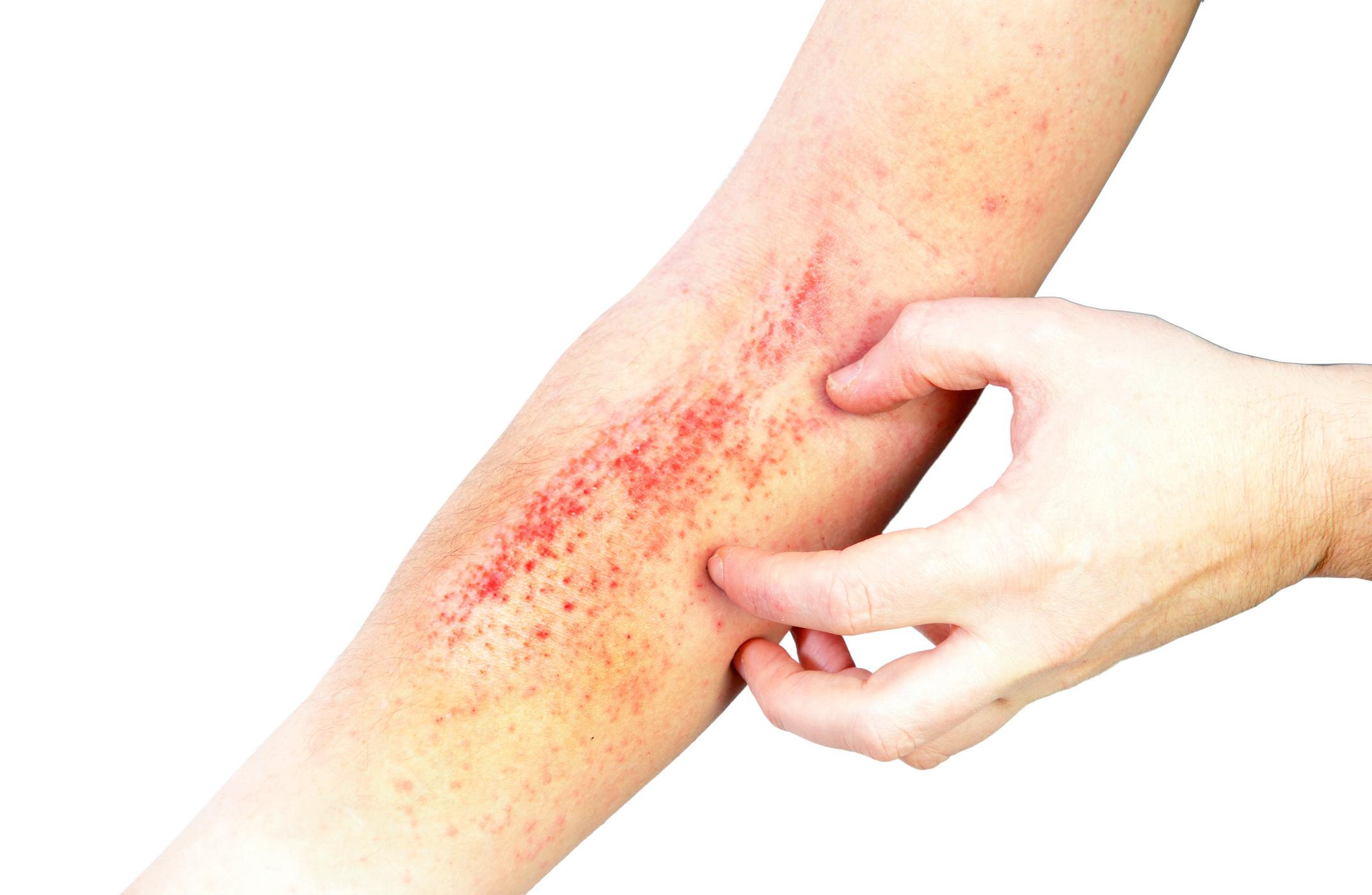
Symptoms of atopic eczema by age:
- Atopic eczema in infancy
The disease usually starts around the 3rd month of life. Boys are more often affected. Bounded reddened areas form on the sides of the face and the scalp, which are very itchy. Scratching leads to the formation of inflammatory swelling of the skin.
Manifestations of the disease may form on the entire scalp, face, trunk and outer parts of the limbs. When the child is crawling, manifestations also form on the knees.
The typical manifestation of atopic eczema is unbearable itching.
Children are tearful, as they cannot sleep at night. There is a high tendency to bacterial secondary infections. In some cases, children may suffer from inflammation of the lymph nodes.
In this form, the symptoms may last for several months. Approximately 50 % of patients will have healed by the end of the second year of life.
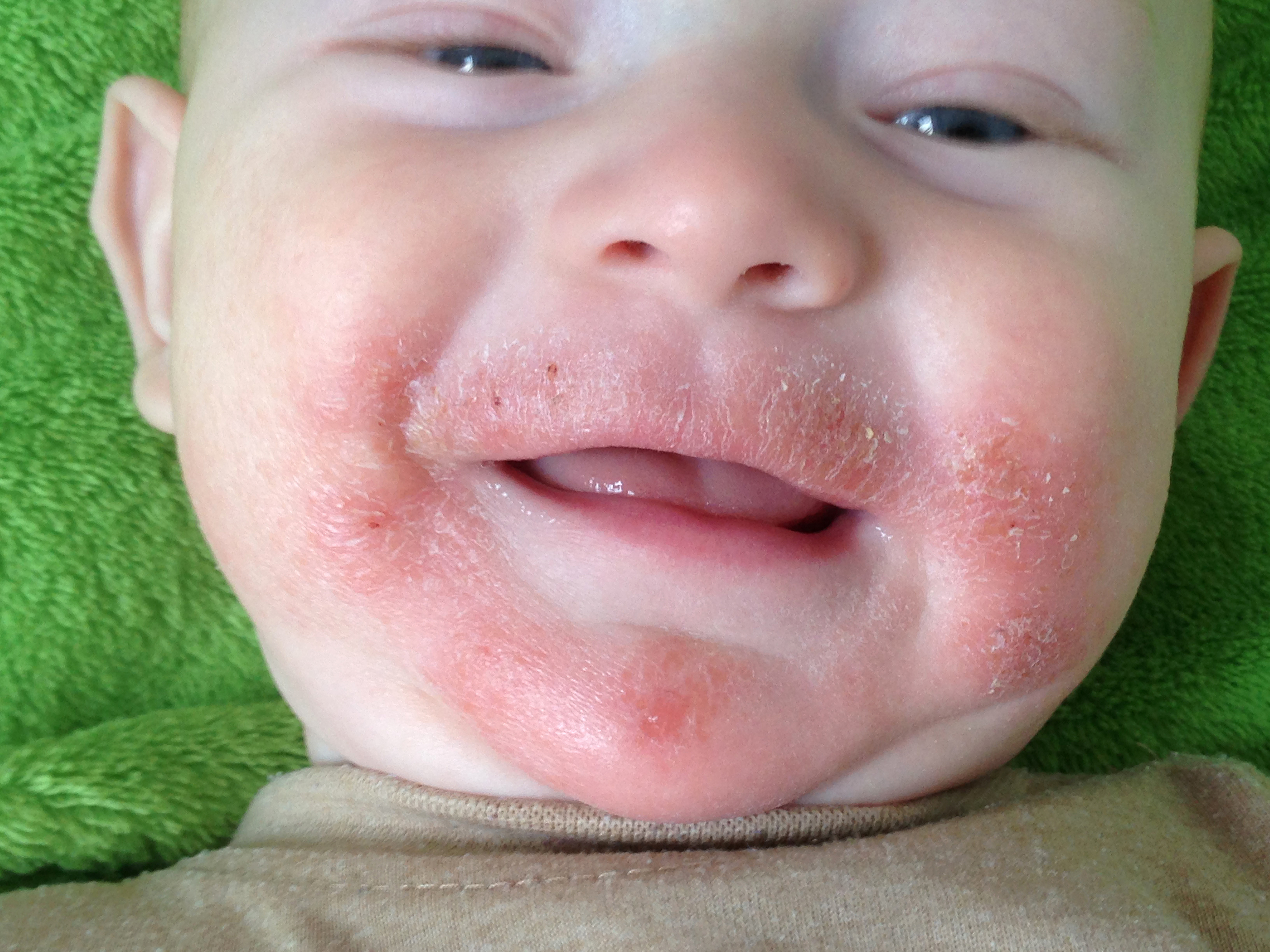
- Atopic eczema in childhood
In childhood, self-ostasis (dry skin) occurs. Typical sites where symptoms form are the large joint areas (elbows, wrists, knee sockets), the back of the head, the sides of the face, the eyelashes, the dorsal parts of the hands and feet.
- Atopic eczema in adolescents and adults
Skin changes are symmetrical.
Predilection sites include the face (forehead, eyelashes, perioral area), neck, upper chest, brachial plexus, flexors of the large joints and dorsum of the hands.
In severe cases of atopic eczema, the skin is red and inflamed. The skin may peel. The patient feels intense itching.
If the scalp is severely affected, hair loss may occur. The hair is dry and lustreless. In men, it grows more into the forehead. In both sexes, there is thinning of the hair on the sides of the forehead.
See also.
The characteristic symptom of atopic eczema in adulthood is intense itching. It has an attack-like character. Itching crises that occur at night cause fatigue and reduced performance in patients.
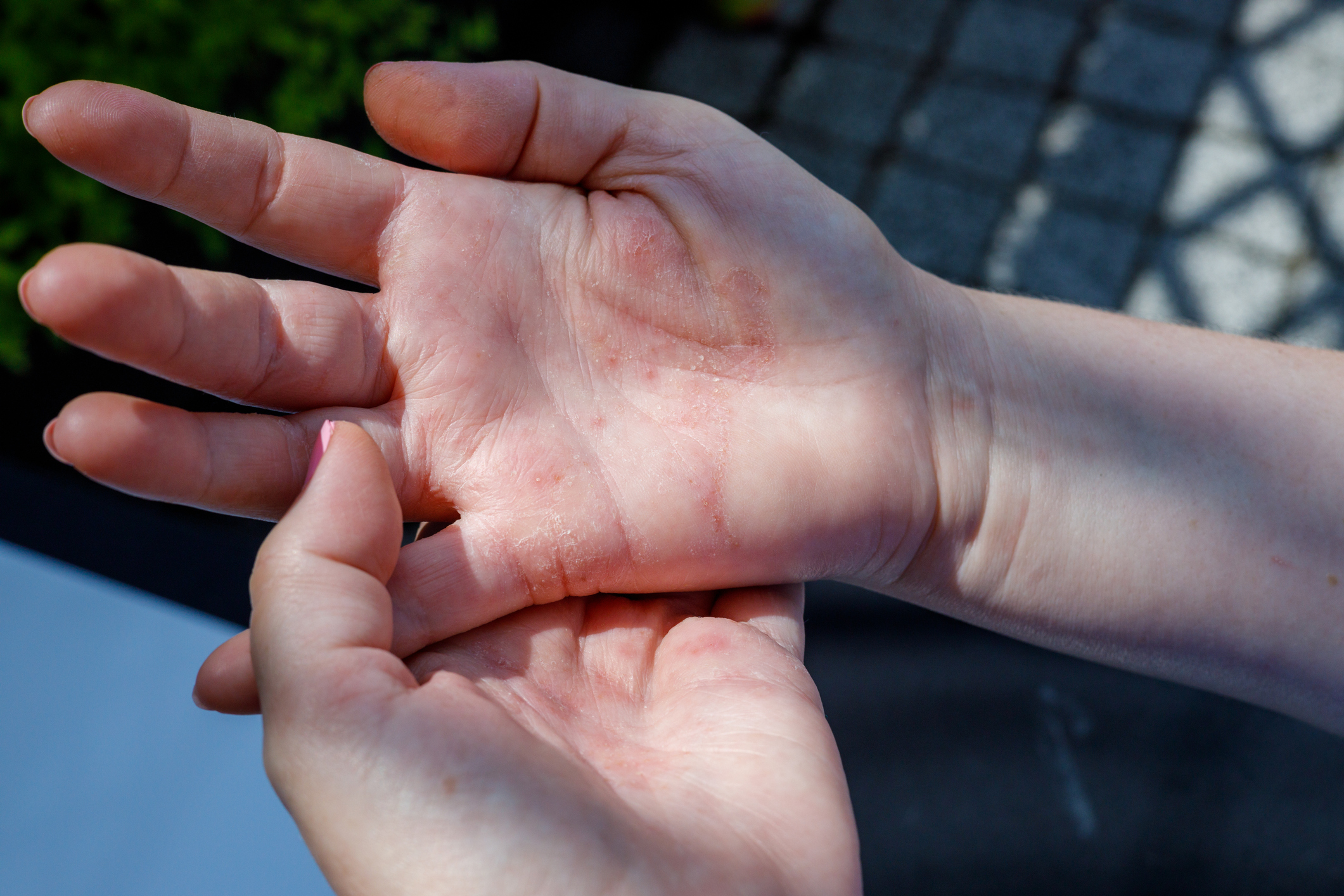
What complications can arise in patients with atopic eczema?
- Bacterial infections
The most common causative agent of bacterial infection is Staphylococcus aureus. Symptoms of staphylococcal infections include redness and crusting.
In such cases, the prescribed treatment ceases to work. The symptoms of atopic eczema begin to worsen.
- Viral infections
Viral infections are mainly caused by herpes simplex. When herpetic eczema occurs, the patient feels pain. The characteristic manifestations of herpetic eczema include round vesicles with milky content.
- Erytroderma
Sometimes also referred to as exfoliative dermatitis. They are a serious complication of atopic eczema. The skin inflammation is manifested by redness and scaling of the skin. General symptoms include tachycardia, fluid and protein loss and impaired thermoregulation.
Diagnostics
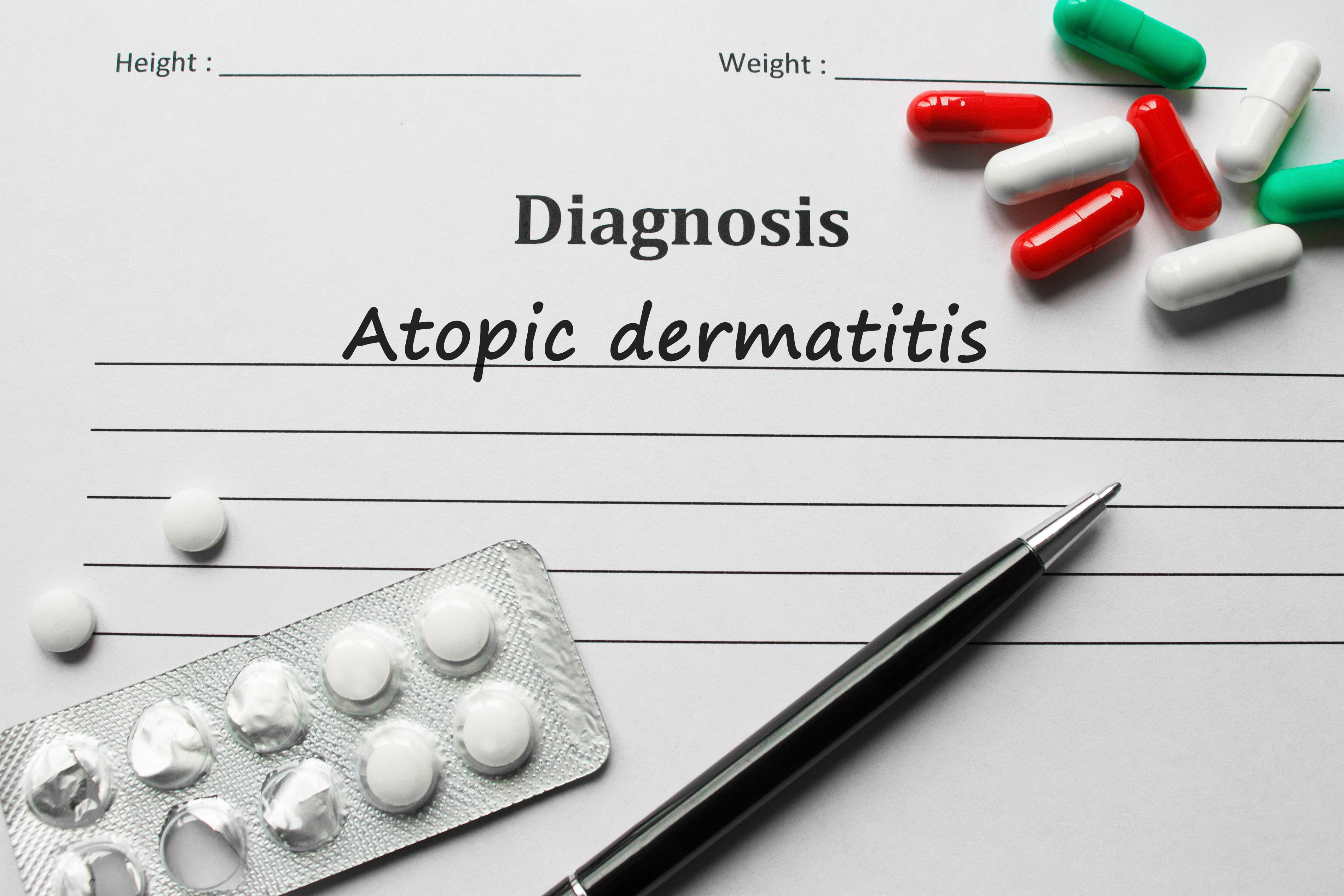
When making a diagnosis, the doctor relies on the typical clinical manifestations of the disease.
In addition to the typical signs of the disease, atopic symptoms should be examined:
- family and personal history
- a tendency to itch - especially after showering and bathing
- increasing skin irritation - sensitivity to wool, soaps
- functional skin disorders - for example, reduced sweat production
- a tendency to scale formation
- sensitivity to food
- increased reactivity to intracutaneous skin tests
Course
In childhood, the symptoms of atopic eczema are scattered over the skin. In adulthood, they become localised. Predicting the course of the disease is difficult. The course of atopic eczema is chronic.
Atopic eczema is characterised by an alternation between a symptom-free period and a flare-up phase. In many cases, improvement occurs in the summer months.
The severity of the disease depends on the extent and intensity of symptoms, response to treatment, complications and impact on quality of life.
Other diseases (allergic rhinitis or bronchial asthma) occur simultaneously with atopic eczema. Patients are at increased risk of developing severe systemic allergic diseases.
Autoimmunity may develop as part of the development of atopic eczema. This phenomenon is called the atopic process.
The atopic process consists of:
- The intrinsic phase - a child with eczema without sensitization
- Extrinsic phase - sensitization to food and environmental allergens
- Autoimmune phase - adult sensitised to own proteins
How to care for the skin of young children?
Bathing young children (infants) should only take a few minutes. They should be bathed 2 to 3 times a week in lukewarm water. Older children should be bathed every day. A daily bath removes allergens, dead skin cells and other substances that have accumulated on the skin during the day.
When bathing, we should avoid using ordinary soaps. It is advisable to use bath additives or special soaps that are designed for atopics. After bathing a child, we should not wipe his/her skin dry.
For young patients, the 3-minute rule applies. This means that the child's skin should be rubbed with emollient within three minutes of bathing. When this rule is followed, the skin remains moisturised.
Wet packs are a very effective aid in relieving itching. Wet packs prevent water loss, bring relief from itching and increase the absorption of topical corticosteroids. After bathing the child, drying and applying emollient, wrap the treated areas in a wet pack and cover with a dry layer. For the wet pack, we can use soaked gauze.
If the deposits of atopic eczema are on the hands or feet, we can use soaked gloves or socks (cotton) as a wet layer. And as a dry layer we use food film or vinyl gloves.
We can keep the wet wraps on for several hours. We can use them overnight, but we must be careful not to let them dry out.
What rules should we follow in our diet?
The foods we eat play an important role in preventing allergic diseases.
In newborns with a positive atopic family history, exclusive breastfeeding is recommended until the 4th to 6th month. In case of hypolactation, it is recommended to give newborns hypoallergenic milk formulas.
We should start introducing non-dairy formulae at the earliest in the 5th month of life. In the first steps we should give single-ingredient formulae. We should keep a gap of 3 to 6 days between new foods. In this way we can identify risky foods and exclude them from the child's diet.
Cow's milk should be introduced into the child's diet after 9 to 12 months of age. Eggs after 1 year of age and nuts and fish after 3 years of age.
In general, patients with atopic eczema should avoid citrus fruits and sweets.
In addition, they should exclude from their diet:
- egg protein
- cow's milk
- wheat flour
- soya
- peanuts

What environment should we provide for a patient with atopic dermatitis?
In the apartment in which we have a child with atopic eczema, it should not be too warm. It is not advisable to place carpets in the rooms. We should not decorate the room with heavy curtains and curtains.
Upholstered furniture should not be placed in the room. Mattresses should be covered with mattress protectors which should be washed twice a month.
What clothes should we wear?
The child should be dressed in soft, light-coloured, cotton clothing. Clothes should not be tight. Wool is not an appropriate material. New clothes should be washed.
The child should not sweat too much in the clothes. Sweating leads to the first signs of atopic eczema.
How it is treated: Atopic eczema
Treatment of atopic eczema: medications, corticosteroids and topical, ointments, creams
Show moreAtopic eczema is treated by
Other names
Interesting resources
Related










